Collecting press
Model and Collectors Mart
Model & Collectors Mart was a UK magazine for collectors; each monthly edition was a thick 170 to 200 pages mostly of adverts with short editorials about aspects of collecting (cars, transport, military, role playing as well as science fiction). Most pages were poor-quality off-white, with some glossy colour pages (always adverts). Around 1999/2000 it was at its peak, but the seed of its destruction was advertising in its pages (ebay). In 2007 it became TV Film Memorabilia, but it doesn't seem to have outlasted 2008.
Peter Halliday looks back at the future and Brian Dowling treks off to Los Angeles to celebrate the day the Moon was blown out of orbit
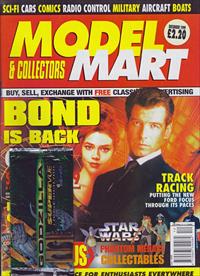
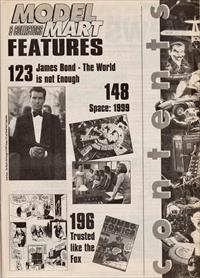
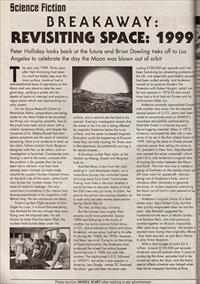
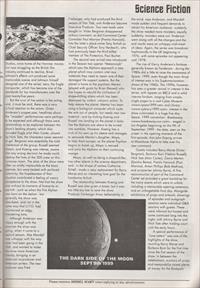
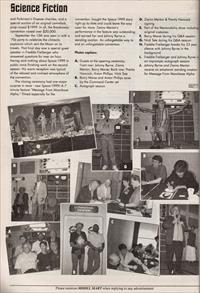
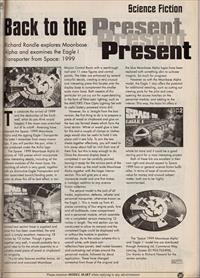
The year was 1999. Thirty years after Neil Armstrong had taken his small but fateful step onto the lunar surface, mankind had a well-established base of operations on the Moon and was about to take the next giant leap, sending a probe into the depths of space to intercept and explore a rogue planet which was approaching our solar system.
On the Space Research Centre at Moonbase Alpha, preparations are being made for the Meta Probe to be launched, but things are not going smoothly. Two of the pilots have been struck down with a violent, mysterious illness, and despite the insistence of Dr. Helena Russell that their severe symptoms are the result of radiation poisoning, there is no evidence to back up her claim. Fellow scientist Victor Bergman disagrees with her, as do others, and an investigation is launched. Commander John Koenig is sent to the moon, unaware that the problem is far greater than he has been led to believe: nine lives have already been claimed, but tests made around the suspect Nuclear Disposal Areas on the dark side of the moon, where Earth now dumps her nuclear waste, find no trace of radiation leakage. The only suspicious circumstance is the intense heat Koenig experiences in his inspection craft. Before long, the two astronauts are dead.
Examining their flight recorder of their Eagle for clues, it is found that everything has blanked for the two minutes they were flying over the disposal sites: the site known as Area One has been filled, the nuclear trash buried deep under the surface, and a second site has had to be opened. Koenig's investigation reveals that the waste at the first site is being affected by magnetic firestorms below the lunar surface, and the same increased magnetic fluctuation could be happening at Disposal Area Two, not only causing the illness seen in the astronauts, but potentially causing a far worse disaster...
A blinding nuclear Flash lights up the horizon as Koenig, Russell and Bergman look on.
And the Moon is torn From her orbit sending it - and Moonbase Alpha - on a hazardous journey into uncharted space. Spinning away from Earth, Commander Koenig must make a decision whether it would be best to abandon Alpha or have the 300 crew stay put since, on Earth, the gravity disruptions are causing disasters on a scale only last seen twelve years earlier during World War III.
The rest, as they say, is history.
But the journey was rougher than anyone could have predicted. Space: 1999 was following in the tracks of another live action science fiction show, U.F.O., and produced by Gerry and Sylvia Anderson, whose savvy had led to hit after hit during the 1960s; the 1970s, however, had been less kind. Trying to cut the strings of Supermarionation, the Andersons had produced the mixed live action/puppet Secret Service in 1969, but with little success. The adult-aimed U.F.O. followed in 1970-71, but while it was popular in America, Lew Grade - whose ITC financed the show - got cold feet; the show was costing £100,000 per episode and had been hamstrung by scheduling problems in the UK; one especially psychedelic episode had been pulled entirely, and Anderson moved on to produce Grade's The Protectors with Robert Vaughn, which ran for two seasons in 1972-74 and would have had a third had not Grade and his co-financiers fallen out.
Anderson promptly approached Grade with another new series. For the aborted second season of U.F.O., plans had been made to concentrate more on SHADO's moonbase (delightfully commanded by Gabrielle Drake in a mauve wig and figure-hugging costume). Now, in 1973, Anderson revamped the idea into new series to be set in the then distant future of 1999. Selling the show to Grade proved relatively easier than selling the show to ITC president in New York, Abe Mandell, who wanted the series contained - which didn't fit in with Anderson's original idea of moving the action between the Moon and Earth. The trick now was to isolate a group of Earthmen on the nearby moon still have room for spacecraft - vehicles being one of Anderson's forte - and to introduce other characters to generate storylines. A nuclear explosion wrenching the Moon out of Earth's orbit seemed to be the answer.
Anderson's original choice of a lead player was I Spy's Robert Culp, but that idea quickly evaporated when he met the actor. Abe Mandell suggested the husband-and-wife team of Martin Landau and Barbara Bain, who had previously worked together on Mission: Impossible. After some busy negotiations - the Landau's wanted more money than originally offered - they were secured, as was Barry Morse to play Victor Bergman.
With a total budget of some £3.5 million - around £35,000 per episode - Anderson was still pushed when it came to producing the show: episodes had to be turned out every ten days, and the heavy special effects schedule was helped when they found cheap(er) facilities at Bray Studios, once home of the Hammer movies but now struggling as the British film industry continued to decline; Brian Johnson's effects unit produced some memorable scenes and Johnson himself designed one of the series' stars, the Eagle transporter, which has become one of the standards for toy manufacturers over the past twenty-five years.
But the crux of live action is the acting and, it must be said, there was a very critical reaction to the actors. Given Anderson's puppet past, headlines about the "wooden" performances were perhaps to be expected and although there were relationships to be explored between the show's leading players, which also included Eagle pilot Alan Carter, played by Nick Tate, the characters never seemed to gel. Bergman was essentially the cold intellectual of the group, Russell seemed distant, and Koenig was intense, aware that any wrong decision he made could destroy the lives of the 300 crew on this runaway moon. The plots of the show were often as wildly implausible as the basic premise, but were treated with po-faced solemnity; the hopelessness of their situation contributed a feeling of weary acceptance to the show. Not that the show was without its moments of humanity or warmth - such as when the first Alphan was born on the station - but the show was downbeat, and not in the same way that U.F.O. had maintained an edgy, threatening tone.
Although Anderson was happy enough with the direction the show was going, when it came to a second season, Abe Mandell was unhappy with the way sales had been going in the USA, and wanted to make the show more American- friendly, bringing in an American co-producer and American writers. The new producer was Fred Freiberger, who had produced the third season of Star Trek, and Anderson became Executive Producer. Two new leads were bought in: Victor Bergman disappeared without comment, as did Command Center Controller Paul Morrow (Prentis Hancock). Into the latter's place came Tony Anholt as Chief Security Officer Tony Verdeschi, who had previously been the third billed member of The Protectors, Paul Buchet.
The second new arrival was introduced in the Season two opener "Metamorph" which saw the Alphans approach a new planet which may contain vital raw materials they need to repair one of their damaged life support systems. But the planet is home to the psychotic Mentor (played with gusto by Brian Blessed) who has hopes to rebuild the civilisation of shape-shifting aliens which has been destroyed by violent, volcanic action. To help restore the planet, Mentor has been using a biological computer Which sucks the wits out of people, but needs new raw material - and by tricking Koenig and Russell into landing on the planet it looks like the Alphans are about to be turned into zombies. However, Koenig has a trick of his own up his sleeve and manages to persuade Mentor's daughter, Maya, to help them escape; as the planet Psychon begins to break up, Maya is rescued and joins the Alphans on their continuing voyage.
Maya, as well as being a shape-shifter, has other talents in the science department, and - in the shape of actress Catherine Schell - made a sexy replacement for Barry Morse and an interesting love goal for the handsome Anholt.
The relationship between Koenig and Russell was also given a boost, but it was too little too late to save the show. Producer Freiberger threw believability to the wind, says Anderson, and Mandell made sudden and frequent demands to attract his American audience - suddenly the show needed more monsters; equally suddenly, monsters were out. Anderson went along with all the changes and the end results were an unhappy mish-mash of ideas. Again, the series was broadcast haphazardly in the UK beginning in 1976, with some episodes not appearing until 1978.
The rise of Gerry Anderson's fanbase - generally known as Fanderson - during the 1980s did a little to raise the awareness of Space: 1999, even though the main thrust of interest was in his Supermarionation shows of the 1960s. The 1990s, however, has seen a greater revival in interest in the series, with repeats on BBC2 and a solid internet fandom, ranging from simple, single pages to a vast Cyber Museum www.space 1999.net and Library www.cybrary 1999.com. Interest in the show culminated in a huge five day Space: 1999 convention - Breakaway www.breakaway-con.com - staged in Los Angeles beginning on the 9th of September 1999 - the date, seen on the screen in the opening moments of the first episode, that John Koenig arrives at Moonbase Alpha to take over his new command.
Guests included Barry Morse (Victor Bergman), Barbara Bain (Helena Russell), Nick Tate (Alan Carter), Zienia Merton (Sandra Benes), Prentis Hancock (Paul Morrow), Anton Phillips (Bob Mathias), and scriptwriter Johnny Byrne. A fine reconstruction of part of the Command Center set provided a great backdrop for the many events which were to unfold, including a memorable opening ceremony and an unforgettable final day. Alongside exhibitions of props and artwork, showings of episodes and autograph sessions were individual Q&A sessions with guests. These were informal but honest and some continued long into the night, with Johnny Byrne and Nick Tate often holding court until the early hours.
A special performance of "Love Letters" was one of the highlights of the show, reuniting Barry Morse and Barbara Bain for the first time since the first season of the show. In between the celebrations, auctions of props and memorabilia raised plenty of money for the Bookpals and Parkinson's Disease charities, and a special auction of an original commlock prop raised $1999. In all, the Breakaway convention raised over $20,000.
September the 13th was seen in with a '70s party to celebrate the climactic explosion which sent the Moon on its travels. That final day saw a special guest speaker in Freddie Freiberger who answered questions for over an hour, having said nothing about Space: 1999 in public since finishing work on the second season. His warm reception was typical of the relaxed and civilised atmosphere of the convention.
The closing ceremony had one major surprise in store - new Space: 1999! A 7 minute feature "Message From Moonbase Alpha," filmed especially for the convention, bought the Space: 1999 story right up to date and could leave the way open for more. Zienia Merton's performance in the feature was outstanding and earned her and Johnny Byrne a standing ovation. An unforgettable way to end an unforgettable convention.
Photos captions:
A. Guests at the opening ceremony: Front row: Johnny Byrne, Zienia Merton, Barry Morse; Back row: Prentis Hancock, Anton Phillips, Nick Tate
B. Barry Morse and Anton Phillips pose by the Command Center set
C. Autograph session
D. Zienia Merton & Prentis Hancock signing
E. Part of the Memorabilia show including original costumes
F. Barry Morse during his session
G. Nick Tate during his Q&A session
H. Freddie Freiberger breaks his 23 year silence with Johnny Byrne in the background
I. Freddie Freiberger and Johnny Byrne in an impromptu autograph session
J. Johnny Byrne and Zienia Merton receive an emotional standing ovation for Message From Moonbase Alpha
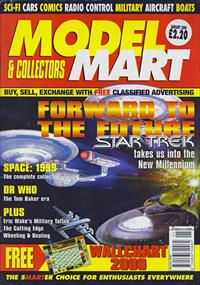

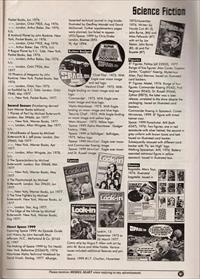

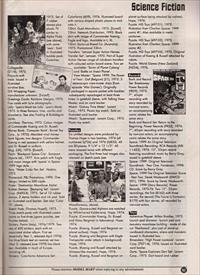
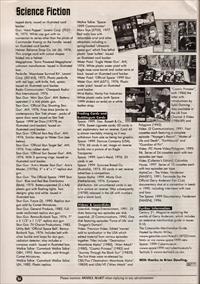
A brief survey of Dinky toys, by Paul Martin.



Space: 1999 copyright ITV Studios Global Entertainment